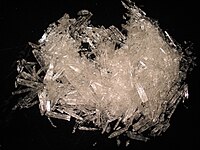
Photo from wikipedia
The first enantioselective ruthenium-catalyzed carbonyl vinylations via hydrogen autotransfer are described. Using a ruthenium-JOSIPHOS catalyst, primary alcohols 2a-2m and 2-butyne 1a are converted to chiral allylic alcohols 3a-3m with excellent… Click to show full abstract
The first enantioselective ruthenium-catalyzed carbonyl vinylations via hydrogen autotransfer are described. Using a ruthenium-JOSIPHOS catalyst, primary alcohols 2a-2m and 2-butyne 1a are converted to chiral allylic alcohols 3a-3m with excellent levels of absolute stereocontrol. Notably, 1°,2°-1,3-diols participate in site-selective C-C coupling, enabling asymmetric carbonyl vinylation beyond premetalated reagents, exogenous reductants, or hydroxyl protecting groups. Using 2-propanol as a reductant, aldehydes dehydro-2a, 2l participate in highly enantioselective 2-butyne-mediated vinylation under otherwise identical reaction conditions. Regio-, stereo-, and site-selective vinylations mediated by 2-pentyne 1b to form adducts 3n, 3o, and epi-3o also are described. The tiglyl alcohol motif obtained upon butyne-mediated vinylation, which is itself found in diverse secondary metabolites, may be converted to commonly encountered polyketide stereodiads, -triads, and -tetrads, as demonstrated by the formation of adducts 4a-4d. The collective mechanistic studies, including deuterium labeling experiments, corroborate a catalytic cycle involving alcohol dehydrogenation to form a transient aldehyde and a ruthenium hydride, which engages in alkyne hydrometalation to form a nucleophilic vinylruthenium species that enacts carbonyl addition. A stereochemical model for carbonyl addition invoking formyl CH···I[Ru] and CH···O≡C[Ru] hydrogen bonds is proposed based on prior calculations and crystallographic data.
Journal Title: Journal of the American Chemical Society
Year Published: 2022
Link to full text (if available)
Share on Social Media: Sign Up to like & get
recommendations!